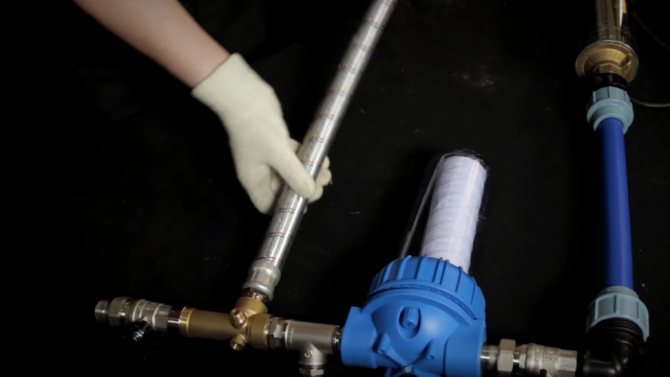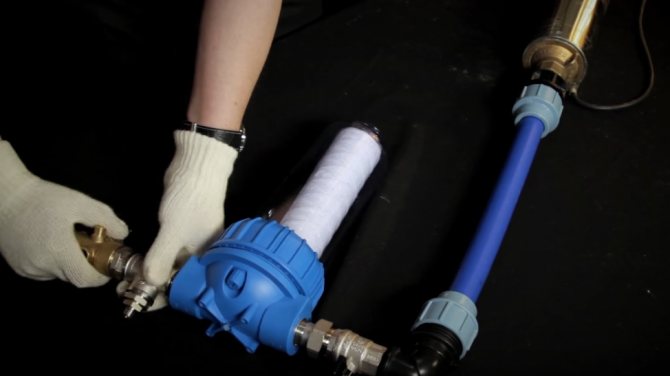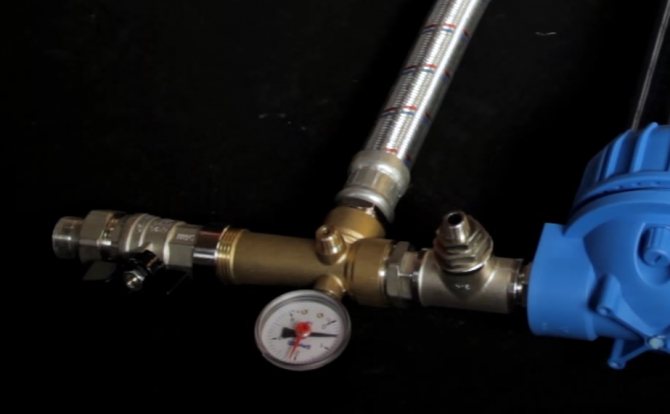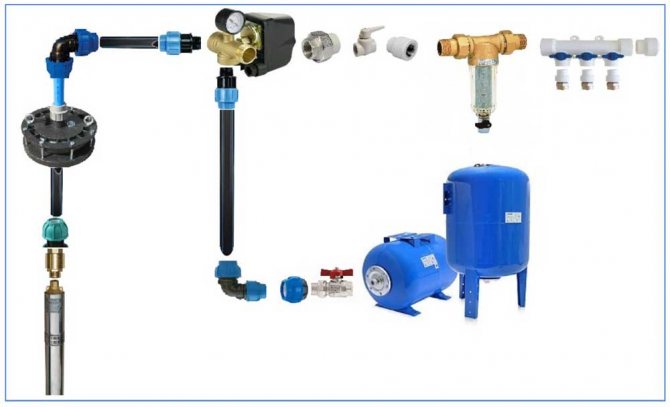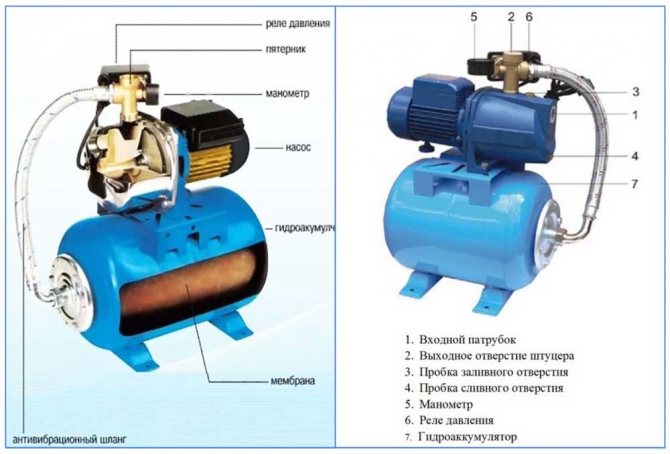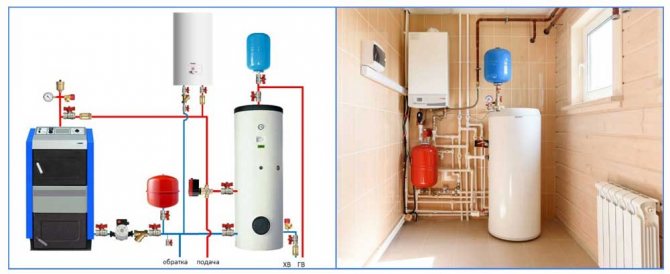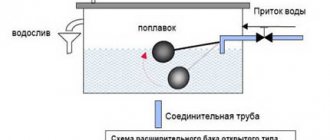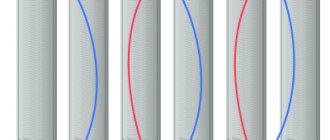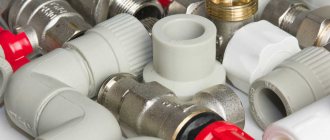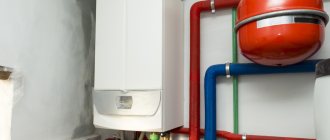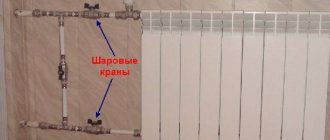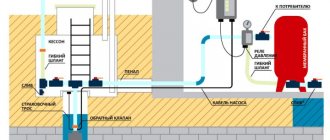Characteristics of closed expansion tanks
Sealed metal containers are used, in which there is a supply of coolant in case of temperature compression of the liquid. This is how the problem of airing the pipeline is solved. If the coolant, expanding during heating, creates too much pressure, the hydraulic tank compensates for the difference.
Despite the apparent simplicity of the design, the expansion tanks are different from each other, and different models have different operating parameters. Structurally, the following types of hydraulic tanks are distinguished:
- Reservoirs for pear replacement.
- Tanks with a permanently installed membrane.
- Tanks that do not have a membrane in the design.
In the first case, the pear acts as a membrane. It is into it that air is pumped, which changes the volume of the working chamber with a thermal increase in the volume of liquid in the system. The air pressure in the expansion tank must be such as to squeeze water into the pipes when the temperature in the radiators drops.
Diaphragm Expansion Tank Applications
Membrane tanks are used in the following cases:
- when arranging heating systems for the operation of which autonomous heat sources are used;
- for the functioning of heating structures connected to district heating networks in accordance with an independent scheme;
- in systems where thermal sheds and solar collectors are used;
- in heat supply schemes in which there are closed circuits and variable operating temperature.
Setting the tank pressure in the water supply system
Initially at the time of sale, plumbing tanks have a standard pressure of 1.5 bar in the tank chamber. The instructions for use indicate the permissible range, which is not recommended to go beyond, especially in the direction of increase.
To correctly set the optimal mode for the hydraulic tank, the following recommendations are taken as a basis:
- The air pressure in the expansion vessel is adjusted after the power supply is cut off.
- The valves must be closed. The water is drained, leaving the container empty.
- The air pressure in the expansion tank is recorded using a pressure gauge.
- In case of non-conformity, the air is pumped up or vented until the values set by the manufacturer are reached.
In the production of hydraulic tanks, inert gases are used instead of air in order to exclude the appearance of foci of corrosion. When manually adjusted, the pressure is made 10% lower than the manufacturer requires.
It should be remembered that after turning on the pump, the working chamber of the hydraulic tank will be filled with water, and only then will it reach the consumer. If the air pressure drops, the head is unstable. And when the equipment is operating normally, it is constant and does not change while using the system.
Adjusting the hydraulic tank in the piping of the water heater
There is one peculiarity here. Such hydraulic tanks should have a slightly higher operating air pressure, namely 0.2 bar higher than what is written in the instructions.
So, if the pump delivers 3.5 bar, the hydraulic tank is set to 3.7 bar. The first functional check and adjustment is performed before starting the system, until the tank is filled with coolant.
No liquid in the chamber is normal operation. And it fills up only when the water in the pipes heats up. Lack of air pressure in the expansion tank leads to the fact that the coolant fills the tank, which is a violation of operational requirements.In this case, it is necessary to turn off and release the system, and then configure the hydraulic tank again.
Purpose of expansion tanks for water supply
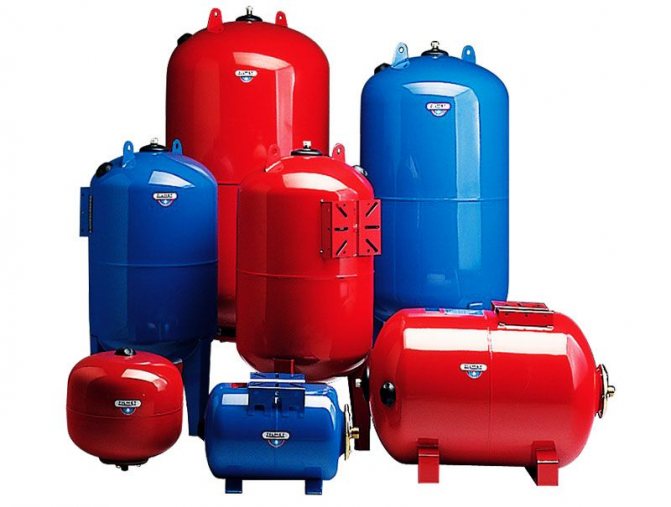
Expansion tanks maintain a constant pressure in the system and store water
The purpose of expansion tanks is to maintain constant pressure in the water supply system of a private or apartment building. Depending on the needs of the residents, you can select the required volume of the tank.
For the plumbing system, the greatest danger is water hammer. This is a sudden change in pressure in the pipes. Distinguish between positive water hammer, when the pressure rises sharply, and negative, in which case it decreases. If positive, a breakthrough of pipes from any material is possible, after which replacement will be required and the house will not be cut off from the water source for some time. More than 60% of pipeline damage cases are due to positive water hammer. It happens as follows: when a tap was opened in the house, a certain amount of water was used, then closed, the liquid in the pipes by inertia continues to flow in the direction of the tap, collides with the partition and begins to flow in the opposite direction. There are two waves - the opposite and the opposite. They collide and burst the pipe.
The use of a diaphragm tank prevents this situation, since the pump is switched off in advance, by a signal from the pressure sensor. The fluid velocity is no longer as high and is not capable of damaging the pipe material.
With the help of an expansion tank, you can create the necessary supply of water. The engine will not turn on again as long as the pressure inside is correct. In the event of a power outage, water will enter the house under the pressure that is created in the system.
In some cases, a membrane tank is installed in a self-contained apartment system to reduce the pressure of the centrally supplied water. The cold water pressure can be so strong that pipe connections in the heating system begin to leak. The membrane tank is a kind of obstacle and does not allow more liquid to enter the apartment than the boiler and pipes can withstand.
With the correct settings, you can achieve almost the same water pressure. If the owner of the equipment is interested in the long-term operation of the pump, he will adjust the sensors so that they work less often, but the pressure may temporarily decrease. In a private house, this leads to the fact that a person in the shower can get burned with hot water, because the pressure of cold water will decrease.
Open type hydraulic tank
Such designs are considered obsolete, since they do not provide absolute autonomy, and can only increase the period between services. The heated liquid evaporates, and its shortage must be eliminated by periodically adding the coolant, replenishing its volume. No diaphragms or pears are used. The pressure in the system appears due to the fact that the open hydraulic tank is mounted on a hill (in the attic, under the ceiling, etc.).
Naturally, there is no air pressure in the open-type expansion tank. When calculating, it is taken into account that one meter of water column creates a pressure of 0.1 atmospheres. However, there is a way to automate water extraction. For this, a float is installed, which, when lowered, opens the tap, and after filling the tank, it rises and blocks the access of water to the tank. But in this case, you still need to control the operation of the system.
Hydraulic tank maintenance rules
The essence of the audit is to check the pressure in the air chamber. The pressure gauge must be in good working order and have an accuracy of 0.1 bar. You can use a car tire pressure tester. Convenient when the scale contains gradation and in atmospheres.Then you do not have to recalculate if the instructions indicate the pressure in other units.
If, as a result of inflation, the air pressure in the expansion tank does not rise, this may indicate that the bulb or membrane has failed and requires replacement. During the inspection, the nipple and valves are checked. They must be sealed.
It is important that this equipment adheres to the parameters set by the manufacturer. It is not worth checking the strength, but after pumping the air should remain in the gas chamber for a long time.
An autonomous water supply system that independently supplies water to parsing points like in a city apartment has long ceased to be a curiosity. This is the norm of suburban life, which just needs to be correctly designed, assembled and equipped with equipment that can start and stop the system as you use the cranes.
Characteristics of closed expansion tanks
A hydraulic tank (or a hydraulic accumulator, an expansion tank) is a metal sealed container that serves to maintain a stable pressure in the water supply system and create water reserves of different volumes.
At first glance, the choice and installation of this device should not cause difficulties - in any online store you can see many models that only slightly differ in shape and volume, but do not differ significantly in their functionality.
It's not like that at all. There are many nuances in the design of the expansion tank and the principle of its operation.
Features of the device and design
Different models of expansion tanks may have restrictions on the way of use - some are designed only to work with industrial water, others can be used for drinking water.
By design, accumulators are distinguished:
- reservoirs with a removable bulb;
- containers with a fixed membrane;
- hydraulic tanks without a membrane.
On one side of the tank with a removable membrane (for a tank with a bottom connection - at the bottom) there is a special threaded flange, to which the pear is attached. On the reverse side there is a nipple for pumping or bleeding air, gas. It is designed to be connected to a regular car pump.
In a tank with a removable bulb, water is pumped into the membrane without touching the metal surface. The diaphragm is replaced by unscrewing the flange held by the bolts. In large containers, to stabilize the filling, the back wall of the membrane is additionally attached to the nipple.
The inner space of the tank with a fixed membrane is divided by it into two compartments. One contains gas (air), the other receives water. The inner surface of such a tank is covered with moisture resistant paint.
There are also hydraulic tanks without a membrane. In them, the compartments for water and air are not separated by anything. Their principle of operation is also based on the mutual pressure of water and air, but with such an open interaction, the two substances are mixed.
The advantage of such devices is the absence of a membrane or a pear, which is the weak link in conventional accumulators.
Diffusion of water and air forces the tanks to be serviced quite often. About once a season you have to pump up air, which gradually mixes with water. A significant decrease in the volume of air, even at normal pressure in the tank, causes the pump to turn on frequently.
The principle of operation of the accumulator
Closed hydraulic tanks for water supply work according to the following scheme: the pump supplies water to the pear, gradually filling it, the membrane increases and the air that is between the pear and the metal body is compressed.
The more water enters the pear, the more it presses on the air, which, in turn, seeks to push it out of the container.As a result, the pressure in the tank rises, this leads to the shutdown of the pump.
For some time, when water is consumed in the system, the compressed air maintains the pressure. It pushes the water into the plumbing. When its amount in the membrane decreases so much that the pressure drops to the lower limit, the relay is activated, again turning on the pump.
Application classification
Tanks for water supply and for the heating system should not be confused, therefore, when choosing, you need to find out their purpose. For clear identification, manufacturers paint accumulators for heating in red, for water supply - in blue.
However, some do not adhere to such marking, so the following data can serve as a distinctive feature of devices:
- for water supply, the maximum operating temperature of the accumulator will be up to 70 ° C, the permissible pressure can reach 10 bar;
- devices intended for the heating system can withstand temperatures up to +120 ° C, the working pressure of the expansion vessel is often not higher than 1.5 bar.
All the most important parameters are indicated on the decorative cap (nameplate) that covers the nipple.
The list of functions that the hydraulic tank performs in the cold water system (cold water supply) is much wider:
- Maintaining an even and constant pressure in the water supply. Due to the air pressure, the pressure is maintained for some time even when the pump is off, until it drops to the set minimum and the pump turns on again. Thus, the pressure in the system is maintained even when several plumbing fixtures are used at the same time.
- Wear protection of pumping equipment. The supply of water contained in the tank allows for some time to use the water supply without turning on the pump. This reduces the number of pump activations per unit of time and prolongs its operation.
- Water hammer protection. A sharp jump in pressure in the water supply system when the pump is turned on can reach 10 or more atmospheres, which negatively affects all elements of the system. The diaphragm tank takes the impact, equalizing the pressure.
- Creation of water reserves. In the event of a power outage, the water supply system will, at least for a short time, still give water for some time.
For piping the water heater, expansion tanks are used that can withstand high temperatures.
Materials for hydropneumatic equipment
The expansion tank diaphragm is made of different materials that withstand different temperature ranges during operation.
In accumulators used:
- Natural rubber rubber - NATURAL. The material can come into contact with drinking water and is used for storing cold water. Over time, it may begin to leak water. Withstands temperatures from -10 to 50 ° C above zero.
- Synthetic butyl rubber - BUTYL. The most versatile, waterproof, used for water supply stations, suitable for drinking water. The operating temperature can range from -10 to 100 ° C.
- EPDM synthetic rubber. More permeable than the previous one, it can come into contact with drinking water. The range of permissible temperatures is from -10 to 100 ° C.
- SBR rubber is used only for industrial water. The usage temperature is the same as for the previous brands.
What are the functions of the expansion tank in the water supply
A diaphragm tank for water supply is a multifunctional device, not a single autonomous system, except for those using expensive submersible electric pumps with frequency control, can not do without its use. To answer the question of why a tank is needed in the system, one should consider its structural design and principle of operation.
All diaphragm tanks consist of two main parts, which include a metal tank and an internal elastic diaphragm with an inlet fitting pressed into the housing cover. When the electric pump is operating on closed taps, water enters the inner elastic shell and it stretches (expands), at a certain moment the water supply stops and the hydraulic tank remains in a filled state.
When the taps are opened, water from the accumulator enters the system with a certain pressure due to the compression of the elastic membrane until the pump restarts, which again pumps water to fill the tank. The process of switching on and off the electric pump is controlled by a pressure switch; to adjust it to the response thresholds, a pressure gauge built into the system is used.
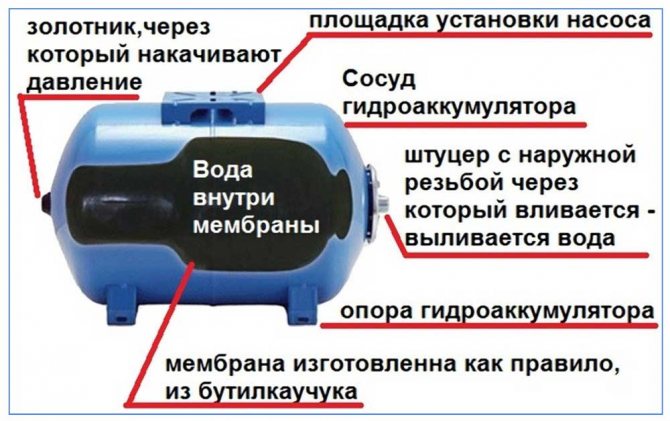

Fig. 2 Structural device of the horizontal tank
Expansion tank for water supply as a hydraulic accumulator
From the principle of operation of the hydraulic tank, it is clear that it accumulates (accumulates) a certain volume of water in its internal bladder or part of the body. Due to this, the required pressure is maintained in the system for a certain time, and a certain amount of water is created, which is useful in emergency situations with a short power outage, water supply damage, or electric pump failure.
Some homeowners install large hydraulic tanks inside their homes to provide significant water supplies.
Hydraulic tank for stabilizing the pressure in the system
Since the tank filled with water gives up water resources for a long time, depending on its volume and consumption, the equal pressure in the water supply system is maintained for a long period of time. In the absence of a storage tank, the pipeline would be freed from water resources faster - this would cause a rapid drop in pressure in the system and frequent activation of the electric pump.


Fig. 3 The principle of operation of the accumulator
Expansion tank for water hammer protection
Water hammer protection is one of the answers to the question of why a hydraulic tank is needed. The principle of compensating water hammer in the system is as follows: when the electric pump is turned off - turned on, there is a sharp stop or movement of water flows. At the same time, due to inertia, water exerts a physical effect on the pipeline shell, shut-off and control valves, transferring its kinetic energy to them. The units and parts of the plumbing system begin to shift, as a result of which threaded and compression connections, pipeline fasteners weaken, and automation malfunctions appear.
An elastic storage tank for a water supply system in the form of a shell inside a hydraulic tank, when moving and stopping the water flow, stretches or contracts in the first place - this allows you to prevent physical impact on other nodes of the water supply system.
Hydraulic accumulator to increase the service life of pumping equipment
The principle of operation of the automatic switching on and off of the electric pump consists in the reaction of the relay to the filling of the hydraulic tank with water - as soon as the inner rubber shell begins to stretch and resist the pressure of the water masses, at a certain moment the pressure switch is triggered and turns off the electric pump. It is clear that the longer the inner shell of the hydraulic tank is filled with water, the longer the pump is in the on state.
Similarly, during water intake, the water from the tank leaves more slowly and, accordingly, the relay to turn on the electric pump is triggered after a significant period of time.


Fig. 4 Hydraulic tanks for heating systems - popular brands
Characteristics of closed expansion tanks
Expansion tanks are cylindrical or spherical tanks with a horizontal or vertical arrangement of the working chamber. They can be floor-standing or suspended.
The equipment is designed to ensure the uninterrupted operation of the water supply systems of a residential building connected to the central network. Hydraulic accumulators are designed to work in the structure of a water supply system that supplies a resource from underground sources (wells, wells). They are supplied in a set of pumping stations, they have the same purpose, but different requirements and operating conditions.
Features of the device and design
The expansion tank is an impermeable container made of high-alloy steel. The space of the working chamber of the device is divided into two parts by a rubber membrane, which can be of two types in its shape and method of attachment.
In the first version, it is a vertically installed valve, on one side of which there is air, and on the other - water. The second modification of the device is made in the form of a solid pear-shaped container made of rubber, which at the bottom, through the outlet valve, is fixed to the body of the device. There is liquid inside the membrane and air outside.
Tanks for domestic use are supplied to the retail network in sizes from 8 to 150 liters. Models from 50 liters are supplied with support stands, a connection for connecting additional devices and a pressure gauge for measuring pressure.
The principle of operation of the accumulator
The principle of operation of the accumulator.
The accumulator is a steel tank with metal supports. There are two chambers inside the body - air and hydraulic. The top of the air chamber is equipped with a nipple through which air can be vented or pumped. The bottom of the tank ends with a special fitting for connecting to the water supply.
The principle of operation of the membrane mechanism is as follows: after starting the pumping station, water is supplied to the tank of the device until the density in the system exceeds the maximum allowable level, after which the relay turns off the accumulator. When the taps are opened, the volume of water in the chamber decreases, the pressure force drops, the machine connects the pump, and the pressure stabilizes.
Application classification
Expansion tanks, in terms of their appearance and manufacturing method, are divided into open and closed structures. Open type equipment is a storage tank that is used in country houses with limited water supply. The size and material of the tank are selected taking into account the required volume of water per day. Chambers of this type are used as additional equipment for heating residential buildings.
Closed-type devices are used to compensate for thermal expansions and stabilize pressure. on the following systems:
- cold water supply;
- hot water supply;
- heating;
- water treatment.
Materials for hydropneumatic equipment
The trouble-free operation of any hydropneumatic unit depends on the correct selection of the diaphragm. Depending on the field of application and operating conditions, the part can be made from the following materials:
- Natural rubber - intended for devices with an operating temperature range of -5 ... + 50 ° С.
- Butyl rubber diaphragm - works within 0… + 120 ° С.
- EPDM is a synthetic elastomer, it is operated in the mode + 1 ... + 110 ° С, the working head of the liquid is up to 12 bar.
- SBR diffuser made of styrene-butadiene rubber for hot and cold water supply - up to 15 bar, + 1 ... + 100 ° С.
Calculation of the volume of the tank before selection
In order to properly set up the water supply system of the apartment, you must not be mistaken in choosing the volume of the expansion tank. The method for calculating the size of the container is based on collecting information about household appliances located in the apartment.
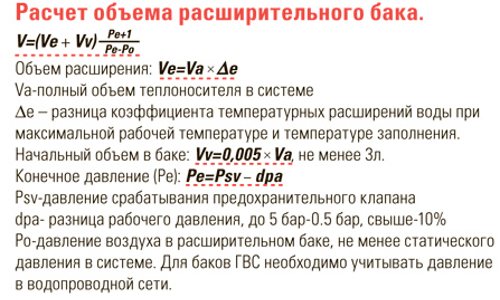

Calculation of the volume of the tank before selection.
We draw up a list of connection points indicating the number of each type of equipment, the frequency of switching on per day and determine the total water consumption coefficient (Cy). For example, there are two washbasins, the total frequency of use is 6 times / day: 2x6 = 12. Such calculations must be made with each item. Then add up all the values. The resulting amount will be an indicator of resource consumption in the apartment.
After that, you need to use the table from the international method of calculating UNI 9182, substitute the total coefficient and select the tank of the required size.
Based on the experience of using the calculation system, the volume of capacity for an apartment is:
- up to 3 consumers - expansion tank up to 24 l;
- up to 8 points - 50 l;
- over 10 devices - 100 liters.
Installation diagrams of closed storage tanks
Since the conversation is about the water supply system of a country house, it must be borne in mind that most often a local water supply system is organized here, pumping water from a well or well. The photo below shows a diagram of the installation of an expansion tank, which is connected to a submersible pump located in a well.
Storage tank in the local water supply system
What is the advantage of this scheme? It is necessary to take into account the fact that the pump works when the pressure inside the water supply network decreases. That is, the consumer turns on, the pump immediately turns on. And the more often water is consumed, the more often the pumping unit turns on and off. But according to passport data, this equipment can be turned on 5-20 times per hour, depending on the brand and model. And what if there were more inclusions. This will certainly lead to the failure of the pump, besides, with such a system, it works almost idle.
The closed-type storage tank installed in the system solves the problem, because the water pumped into the membrane tank is already under pressure, which means that it will act on the entire water supply line. That is, as long as there is pressure in the tank, the pump will not pump water, switching on and off will drop to a minimum. In addition, the accumulator tank itself smooths out the pressure in the network when the pump is started. And this is the absence of hydraulic shocks, which can disable the entire water supply system.
For obvious reasons, hydroaccumulators are more efficient storage devices for water than conventional tanks. But they are more expensive, it is impossible to regulate the pressure limits without knowledge and experience. You can knock off the adjustment. And they must be installed correctly.
Installation of a storage tank for water
In this regard, conventional tanks are both easier to maintain and easier to install. They are inexpensive depending on the size. Such a storage tank can even be made by hand. By the way, storage tanks include not only finished products that are sold in all hardware stores, or do-it-yourself containers. Wells or concrete tanks can be used for them. The main requirement for these structures is the complete tightness of the structure, which is easy to ensure with the right approach to construction.
That is, it turns out that the storage tank for water supply at home is a fairly wide range of designs. Choosing one of them for the necessary needs is as easy as shelling pears. The main thing is to understand that much will depend on the financial capabilities of the consumer. Life shows that plastic water storage is the best option in this case. It is cheap, it is a guarantee of durability and long-term operation, it is a huge choice in terms of tank volume. This can be added to the ease of installation and piping, which does not require the use of complex technologies and tools.
otepleivode.ru
Hydraulic tanks connection diagrams
In order to connect hydropneumatic tanks to a cold or hot water supply, they must be equipped with:
Hydraulic tank connection diagram.
- supply, drain and discharge branch pipes;
- pressure gauge;
- safety valve;
- level sensor;
- nipple - a device for regulating and replenishing air.
Expansion tanks for cold water are installed at the lowest point of the distribution system. Hot water supply tanks are mounted on the pipeline route from the side of the liquid supply to the heating equipment (heat exchanger, boiler, etc.).
Performing the expansion tank installation
The unit is installed in a room with a temperature of at least 0 ° C. The minimum distance from walls and floor slabs is no more than 60 cm. Around the installed equipment, it is necessary to provide a passage for access to the air valve, drain valve, shut-off valves. The influence of the weight of the connected equipment and pipelines on the device case is not allowed
Before installing the hydraulic tank in the chamber, it is necessary to measure the air density with a pressure gauge; it must correspond to the technical characteristics of the mechanism. Fine adjustments can be made through the nipple at the top of the tank. The installation of the device (vertically or horizontally) depends on the volume of the tank and is indicated in the recommendations of the manufacturer when purchasing the equipment.
Features of adjusting the accumulator
Setting the operating characteristics of the accumulator is as follows:
- We check the pressure in the air chamber. To do this, we connect the pressure gauge to the rubber valve located at the top of the tank.
- If the obtained values do not correspond to the recommended ones, then by pressing the nipple we bleed the air and reduce the pressure or pump gas to increase the pressure.
- Then we open the protective cover of the relay and, using a large nut, adjust the upper trigger level, which is responsible for stopping the pump at maximum pressure.
- The lower limit of the start of the equipment is adjusted by the small fixture.
- We close the relay case and check the results.
Setting the tank pressure in the water supply system
The accumulator is supplied to the retail network with the basic settings of the equipment manufacturer. Sometimes these parameters do not correspond to the operating conditions.


Setting the tank pressure in the water supply system.
The adjustment of the expansion tank operation is shown in the following situations:
- After installing the unit. Adjustment of values according to the technical regulations of the region.
- Weak head in the system.
- The tank does not fill up.
- Replacing the membrane with a new one.
- Repair of the highway.
- In the air chamber, the recommended values are exceeded, the bases are the readings of the manometer.
- The temperature regime of the hot water supply is violated.
When adjusting the pressure in the gas compartment of the device, it should be taken into account that to protect the container from corrosion, the air chamber is filled with dry nitrogen at the factory. Therefore, when adjusting the air density in the gas cavity or filling the tank after changing the membrane, it is recommended to use technical nitrogen.
The safety valves of the device must be adjusted so that the working pressure in the protected segment does not exceed the standard by more than 10%, and at a set value up to 0.5 MPa ≤ 0.05 MPa.
Adjustment of the hydraulic tank in the piping of the water heater
Expansion tanks for hot water systems compensate for changes in the volume of liquid within the limits of the permissible minimum and maximum temperatures, and also maintain the pressure in the design range.
A diaphragm tank for hot water is installed directly at the point of supply of cold water to the system. Installation of the reservoir after the pressure reducer is considered optimal.The air concentration in the accumulator chamber must be 0.25 bar higher than the operating pressure in the main line, or 0.2 bar higher than the set pressure at the reducer outlet.
With this setting, excess water that periodically appears in the system due to an increase in temperature will gradually be dumped back into the pipeline during the cooling process.
The principle of operation and features of the expansion tank
The current tank design was not immediately developed. Now they use designs of a new type, and the old ones are practically not used. In the previous example, after the system warmed up, excess water entered the open tank, and when the system cooled down, the water flowed back into the pipes. In such a system, there was a danger of hot water coming out of the tank, which could cause flooding of the house. (See also: Do-it-yourself boiler installation)
The water that has come from the well is under pressure, and the membrane increases at this time, the volume of air decreases, and some pressure is created. The pump turns off when the pressure reaches the required level. Water is consumed, respectively, the pressure drops, and the pump turns on to maintain the pressure. The disadvantage of an expansion tank is an irrational method of temporary storage of water. The Dutch were the first to propose the use of membrane expansion tanks. Today, closed expansion tanks are very aesthetic and have different designs.
Figure 3: Expansion vessel in action
The diaphragm expansion tank for water supply also has a drawback, which is that the membrane cannot be replaced with such a design. If the heating system is working properly, then the liquid expands when the water starts up, and otherwise the pressure fluctuations pass smoothly. The membrane of such a tank is made of high quality material and lasts a very long time.
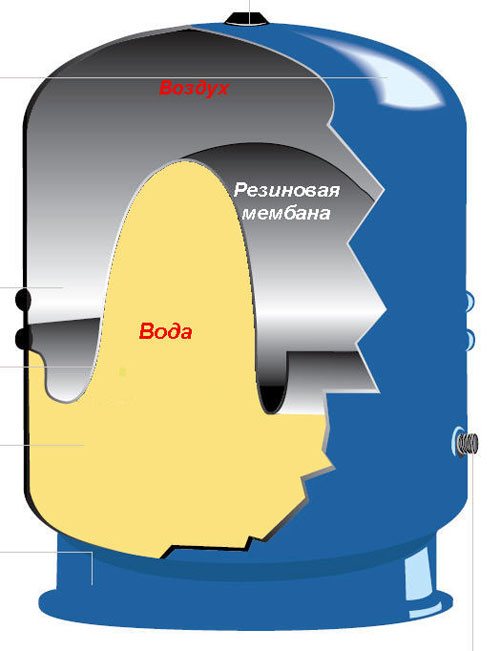

Figure 4: Diaphragm expansion vessel for water supply
Advice! Do not forget to check the air pressure before each heating season. For systems that have large volumes, it is best to use a stationary pressure gauge. (See also: Accumulators for water supply)
With the help of a diaphragm expansion tank, hydrodynamic shock is compensated, which significantly reduces the frequency of pump operation. This design extends the service life and saves electricity. When the coolant is heated or cooled, the system remains intact. This compensates for the volume of changes and it is for this that a diaphragm expansion vessel is installed. Even during a power outage, the reserve tanks have a fire extinguishing function. It is possible to use membrane tanks not only in domestic systems, but also in industrial ones, since the working pressure is calculated up to 16 bar. Accumulators can be horizontal and vertical, open and closed. In addition, they differ in terms of water volume and operating pressure.
Hydraulic tank maintenance rules
Hydraulic tank maintenance rules.
Installation, testing and repair of equipment should be carried out in accordance with the recommendations of the manufacturer by specialists who have undergone special training.
Any changes to the expansion chamber design using welding or mechanical stress are prohibited.
Once a year, a preventive inspection of the hydraulic tank is required:
- Check the pressure in the air chamber.
- Carry out an external inspection of the unit body.
- Examine instrumentation (pressure gauge, valves, relays, etc.).
- Inspect the tightness of pipelines and the operation of valves.
Installation of compensation tanks
Installation of expansion tanks is carried out in accordance with the installation rules and depends on the type of heating system.
Open systems
The main requirement for an open-type heating system is the rapid rise of the expanding coolant to the top point of the system and the possibility of its movement through the pipes by gravity. In this case, the air from the circuit also rises up. By installing an expansion tank at the top of the system, both conditions are successfully solved.
The compensation tank itself for this case is a water tank with an open top, into the bottom of which a branch pipe is cut to connect the pressure branch of the heating. Installation of the device is carried out both by welding steel pipes and by connecting polypropylene elements using a soldering iron. It is only important to provide the required flow area of the pipeline.
Closed system
In heating with a closed circuit, the installation of an expansion tank requires adherence to certain rules:
- installation is allowed only at positive temperatures;
- the expansion tank is connected in a straight section of the line in front of the circulation pump;
- installation of a safety valve in parallel with a compensation tank is mandatory;
- when choosing an installation site, it is necessary to provide access to the tank valve, safety valve and shut-off valves;
- the minimum volume of the expansion tank is taken equal to 10% of the volume of the coolant.
Modern gas boilers are often equipped with small expansion tanks (6-8 liters), therefore, if it is necessary to connect a long heating circuit, an additional tank is installed.
If, during heating operation, the pressure is released from the system through the safety valve too often, this means that the volume of the expansion tank is insufficient.
Preparatory work
Before starting work, the expansion tank must be adjusted. To do this, remove the plastic cover from its valve, connect a compressor or pump, and pump air into the device using a pressure gauge until the pressure rises to 1.1 kPa. During operation, you will have to make additional adjustments to this parameter. The pressure in the discharge line must be 0.1-0.2 kPa higher than in the compensation tank.
Installation instructions
As in open systems, the connection of the expansion tank can be done by welding metal or polypropylene elements or metal-plastic pipes. It should be said that the last option is the least preferred. Welding steel pipes is, of course, the most reliable connection, but, most likely, such an installation will be entrusted to a specialist, therefore, there is no need to describe the welding technology here. But the connection with polypropylene pipes is quite reliable and affordable for repetition with your own hands. We will tell you more about it.
- The boiler is disconnected from the network, the water supply taps to the unit are closed.
- The liquid is drained from the heating system.
- The tank is strapped. To do this, cut a pipe of the required length, to which an American fitting is soldered on one side. A tee fitting is attached to its other end.
- In the selected place of the return line, a tee with a strapping is cut in.
- A safety valve is installed on the tank branch pipe, and below - a shut-off valve. This arrangement will allow the water to drain off to check the pressure in the air chamber of the device. The joints are sealed with tow or fum tape.
- Connect the assembled structure to the system.
- The heating system is filled with water, after opening the Mayevsky taps on the radiators.
- The system is considered filled with liquid when a pressure of 1.2-1.3 kPa is reached.
Installing a shut-off valve in the area between the expansion tank and the heating circuit will allow you to remove the device for repair or replacement without draining the water from the heating system.
Open type hydraulic tank installation
Expansion tanks of an open type are attachments that are mounted at the top of the line. The installation site must be well ventilated to avoid the formation of condensation on the surface of the device. The height of the container should allow free access to the inside of the container for technical inspection or repair of the working chamber.
The reservoir is equipped with a float valve, which is installed on the inlet line. It is designed to maintain the liquid level in the storage chamber, which prevents overflow of water over the edge of the tank.

